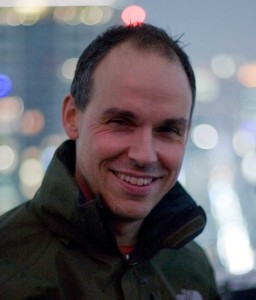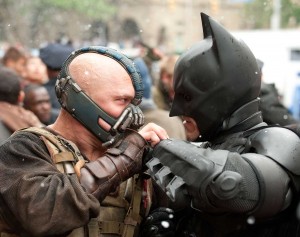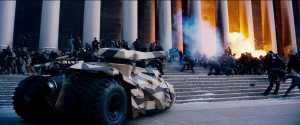![]()

And there are advantages to having a good working relationship with a director. “A lot of our working process had been laid down,” he allowed, despite the fact this Dark Knight installment had a lot more IMAX work in it than its predecessor.
Noting the director’s preference – insistence, even– on photo-realistic visual effects and the penchant for the big screen formats, Franklin said. “You have to go in with more infrastructure,” since more digital information is being shuttled between more servers.

Additionally, since Nolan famously likes to shoot on film, there was often a 10-day turnaround on getting scenes printed and projected, in terms of how the high resolution shots would look, so often a lower resolution 2K proxy was used. “The first person to see the high-resolution version would be Chris Nolan,” Franklin said, but all parties had gotten pretty good on this process over several films together, with “none of that business of having to get to know somebody.”
Franklin likens some of that process to “the way we worked with video resolution 20 years ago,” meaning trusting a low-res version you were seeing on an on-set monitor and having a lot of faith that the hi-res versions, which in this case needed to be IMAX-ready and worthy, would all turn out. After all, he added, “Chris’ films run like clockwork.”
A combination of post houses and overlapping schedules were deployed to accommodate the compressed timeframe. Miniature work was being done at New Deal Studios, for example, while they were still shooting the rest of the movie. Filming in Pittsburgh (doubling for Gotham) commenced while VFX work was unfolding in London, and then there were the extra-compressed elements, namely, the prologue and football stadium sequences, which needed to be finished in advance to help “tease” the film. Franklin pointed out the Dark Knight’s prologue had eight FX shots in it and “this had 40.”
The schedule called for getting the work delivered by end of January/early February of this year, with a director’s screening slated for mid-March, as they headed toward the final release of what he terms a “cerebral type of summer movie.”

As for what’s next – in addition to any trips to L.A. that may be warranted during Award season – Franklin is looking for “a good long break over the summer, and getting reacquainted with my family.”
At the same time, he cites several projects being overseen by Double Negative, the post house where he’s based, including projects by directors Ron Howard and Paul Greengrass. Perhaps that break won’t be quite as long as he’d hoped. “Well,” he opined, “there’s no rest for the wicked.”
Which is precisely something Batman might have said about Gotham City.





